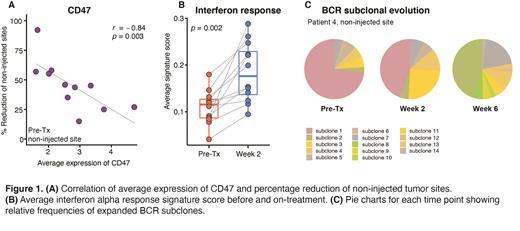Abstract
The efficacy of an induced anti-tumor immune response is determined by a dynamic interaction and co-evolution of tumor cells and their microenvironment, leading to continuous changes in cellular and molecular properties of the tumor. Therefore, longitudinal tracking of subclonal evolution and the interplay between tumor and immune cells is important to dissect anti-tumor immunity and develop novel immunotherapy strategies. In situ vaccination is an effective immunotherapeutic treatment in indolent lymphoma, prompting tumor regression in the treated tumor site as well as in the untreated tumor sites (Frank et al., Cancer Discov 2018, Hammerich et al., Nat Med 2019). Here, we investigate dynamic implications of in situ vaccination on follicular lymphoma (FL) tumor cells by performing single cell RNA sequencing (scRNA-seq) and single cell B cell receptor sequencing (scBCR-seq) on serial samples from a clinical trial.
Tumor specimens from 12 patients with FL enrolled in an ongoing in situ vaccination trial (NCT02927964) were selected for this analysis. As study treatment, one lymphoma site is treated with low-dose radiation (2Gy d1, 2Gy d2) and intratumoral injection of a TLR9 agonist (CpG) weekly for 5 doses. In addition, after 2 CpG injections, the patients receive daily oral ibrutinib, used here to enhance the T cell dependent systemic anti-tumor response (Sagiv-Barfi et al., Blood 2015). To profile the locally and systemically induced changes in tumor cells, fine needle aspirates were obtained serially - prior to treatment and, when possible after 1 and 6 weeks of treatment - from the injected and a non-injected tumor site. These specimens were subjected to scRNA-seq and scBCR-seq using the 10x chromium platform. On average, we sequenced 7,903 cells per sample detecting an average of 1,344 median genes per cell.
We were able to analyze 68 patient samples including samples from both tumor sites and all time points. In total, we identified 198,640 tumor cells based on clonal light chain expression and presence of inferred copy number alterations. Longitudinal examination of the tumor cells revealed transcriptional changes during therapy at both the injected and non-injected sites, some of which related to clinical regression in the non-injected sites reflecting the induced immune-mediated anti-tumor response. In the pre-treatment samples, we found that increased expression of inflammation related pathways by tumor cells significantly correlated with inferior clinical response. In addition, tumor cell expression of the "don't eat me" signal CD47 was associated with less abscopal tumor regression (Fig. 1A), implicating CD47 as a potential target of future combination therapy. Among all patients, we detected a strong interferon alpha response to treatment at the injected tumor sites (Fig. 1B), though this did not correlate with clinical response. In contrast, therapy-induced expression of the MHC II genes was associated with abscopal clinical regression. Using the scBCR-seq data, we inferred the putative original tumor V(D)J sequence in each case and identified its somatically mutated derivatives. Tumor BCR subclones were defined as tumor subpopulations that had identical mutated V(D)J sequences. Tracking BCR subclones that were comprised of at least 15 cells, we discovered notable subclonal shifts at both the locally injected and the non-injected tumor sites during therapy (Fig. 1C). While the BCR subclone composition was similar within the 1-2 week time frame, several pre-existing subclones become dominant by the week 6 time point, suggesting possible selection for resistance phenotypes.
Our translational single cell study provides a deep analysis of the tumor cell response during in situ vaccination in lymphoma patients, demonstrating not only dynamic changes in tumor cell phenotypes, but also therapy-induced differences among patients that correlated with clinical response. By integrating scRNA-seq and scBCR-seq data, we also have the unique opportunity to characterize BCR subclones transcriptionally, to link their phenotypes to tumor regression or resistance and to discover new targets for combinational therapies.
Shree: Gilead: Other: Spouse's employment. Levy: GigaGen: Membership on an entity's Board of Directors or advisory committees; Teneobio: Membership on an entity's Board of Directors or advisory committees; Nurix: Membership on an entity's Board of Directors or advisory committees; Dragonfly: Membership on an entity's Board of Directors or advisory committees; Apexigen: Membership on an entity's Board of Directors or advisory committees; Viracta: Membership on an entity's Board of Directors or advisory committees; Spotlight: Membership on an entity's Board of Directors or advisory committees; Immunocore: Membership on an entity's Board of Directors or advisory committees; Walking Fish: Membership on an entity's Board of Directors or advisory committees; Kira: Membership on an entity's Board of Directors or advisory committees; Abintus Bio: Membership on an entity's Board of Directors or advisory committees; Khloris: Membership on an entity's Board of Directors or advisory committees; Virsti: Membership on an entity's Board of Directors or advisory committees; BiolineRx: Membership on an entity's Board of Directors or advisory committees; BeiGene: Membership on an entity's Board of Directors or advisory committees; Quadriga: Membership on an entity's Board of Directors or advisory committees.


This feature is available to Subscribers Only
Sign In or Create an Account Close Modal